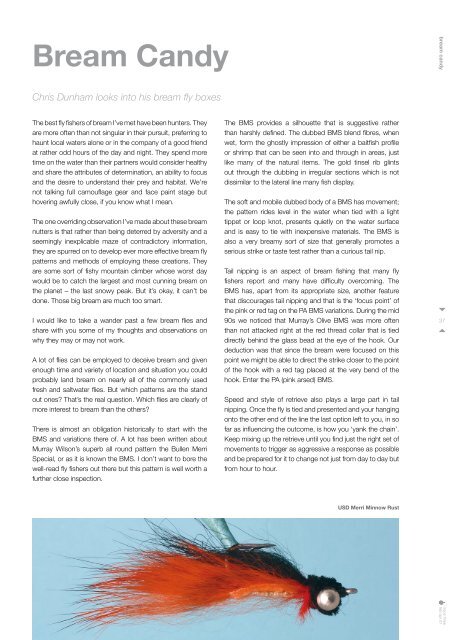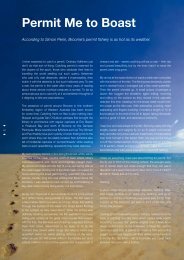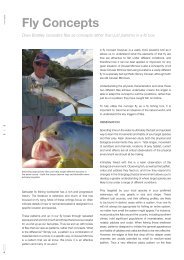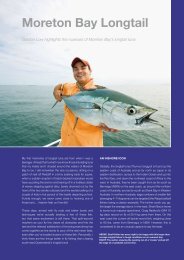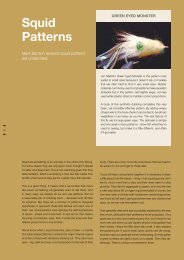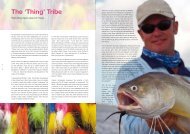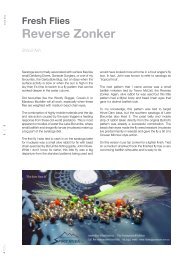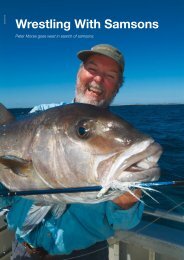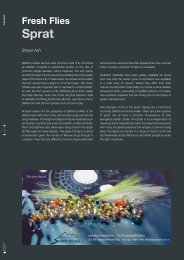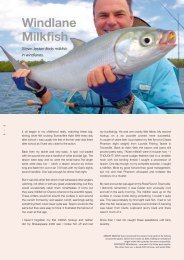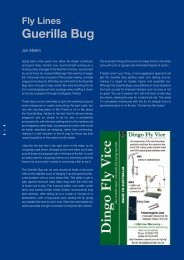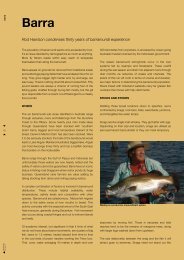Bream Candy - Fly Angler Australia
Bream Candy - Fly Angler Australia
Bream Candy - Fly Angler Australia
You also want an ePaper? Increase the reach of your titles
YUMPU automatically turns print PDFs into web optimized ePapers that Google loves.
<strong>Bream</strong> <strong>Candy</strong><br />
bream candy<br />
Chris Dunham looks into his bream fly boxes<br />
The best fly fishers of bream I’ve met have been hunters. They<br />
are more often than not singular in their pursuit, preferring to<br />
haunt local waters alone or in the company of a good friend<br />
at rather odd hours of the day and night. They spend more<br />
time on the water than their partners would consider healthy<br />
and share the attributes of determination, an ability to focus<br />
and the desire to understand their prey and habitat. We’re<br />
not talking full camouflage gear and face paint stage but<br />
hovering awfully close, if you know what I mean.<br />
The one overriding observation I’ve made about these bream<br />
nutters is that rather than being deterred by adversity and a<br />
seemingly inexplicable maze of contradictory information,<br />
they are spurred on to develop ever more effective bream fly<br />
patterns and methods of employing these creations. They<br />
are some sort of fishy mountain climber whose worst day<br />
would be to catch the largest and most cunning bream on<br />
the planet – the last snowy peak. But it’s okay, it can’t be<br />
done. Those big bream are much too smart.<br />
I would like to take a wander past a few bream flies and<br />
share with you some of my thoughts and observations on<br />
why they may or may not work.<br />
A lot of flies can be employed to deceive bream and given<br />
enough time and variety of location and situation you could<br />
probably land bream on nearly all of the commonly used<br />
fresh and saltwater flies. But which patterns are the stand<br />
out ones? That’s the real question. Which flies are clearly of<br />
more interest to bream than the others?<br />
There is almost an obligation historically to start with the<br />
BMS and variations there of. A lot has been written about<br />
Murray Wilson’s superb all round pattern the Bullen Merri<br />
Special, or as it is known the BMS. I don’t want to bore the<br />
well-read fly fishers out there but this pattern is well worth a<br />
further close inspection.<br />
The BMS provides a silhouette that is suggestive rather<br />
than harshly defined. The dubbed BMS blend fibres, when<br />
wet, form the ghostly impression of either a baitfish profile<br />
or shrimp that can be seen into and through in areas, just<br />
like many of the natural items. The gold tinsel rib glints<br />
out through the dubbing in irregular sections which is not<br />
dissimilar to the lateral line many fish display.<br />
The soft and mobile dubbed body of a BMS has movement;<br />
the pattern rides level in the water when tied with a light<br />
tippet or loop knot, presents quietly on the water surface<br />
and is easy to tie with inexpensive materials. The BMS is<br />
also a very breamy sort of size that generally promotes a<br />
serious strike or taste test rather than a curious tail nip.<br />
Tail nipping is an aspect of bream fishing that many fly<br />
fishers report and many have difficulty overcoming. The<br />
BMS has, apart from its appropriate size, another feature<br />
that discourages tail nipping and that is the ‘focus point’ of<br />
the pink or red tag on the PA BMS variations. During the mid<br />
90s we noticed that Murray’s Olive BMS was more often<br />
than not attacked right at the red thread collar that is tied<br />
directly behind the glass bead at the eye of the hook. Our<br />
deduction was that since the bream were focused on this<br />
point we might be able to direct the strike closer to the point<br />
of the hook with a red tag placed at the very bend of the<br />
hook. Enter the PA (pink arsed) BMS.<br />
Speed and style of retrieve also plays a large part in tail<br />
nipping. Once the fly is tied and presented and your hanging<br />
onto the other end of the line the last option left to you, in so<br />
far as influencing the outcome, is how you ‘yank the chain’.<br />
Keep mixing up the retrieve until you find just the right set of<br />
movements to trigger as aggressive a response as possible<br />
and be prepared for it to change not just from day to day but<br />
from hour to hour.<br />
37<br />
USD Merri Minnow Rust<br />
issue three<br />
feb-apr 07
38<br />
issue three<br />
feb-apr 07<br />
Opposite Page: from top to bottom - BMS Estuary PA Chartreuse, Fuzzel Chartreuse Bead Chain, Mini FPF Purple, KBF Yellow and BMS Estuary Tan.
The original Olive BMS has spawned many variations in<br />
size, weight, colour and hook profile but all have the one<br />
common thread of a dubbed and teased out BMS blend<br />
body. By pinching together various colours of BMS Blend<br />
any number of subtly variations in tone, colour and highlight<br />
can be achieved. BMS flies tied on a stainless hook, usually<br />
a Mustad Allrounder #6, are referred to as an Estuary BMS<br />
and are a good platform to start imitating aspects of marine<br />
life from your local estuary.<br />
bream candy<br />
The BMS Hammerhead is an upside down (point up)<br />
weighted BMS variation originally tied for deep water<br />
breaming and hunting WA bonefish. It should be noted that<br />
all of the BMS variations can be tied on freshwater, stainless<br />
or stinger hooks, for bream or bass for that matter. The<br />
freshwater hooks are usually super sharp but rust quickly<br />
and will straighten on large fish. The stainless are not as<br />
sharp but less likely to straighten and less inclined to rust.<br />
Stingers are somewhere between the two; being black<br />
nickelled they take longer to rust than the freshwater hooks<br />
and are super sharp.<br />
Murray usually ties Hammerheads on the Mustad Signature<br />
Series Tarpon hook which has a very good point and a<br />
strong shape.<br />
The more successful Hammerhead colour variations to date<br />
are black (which has hints of red, purple and green through<br />
it), purple and pink arsed black, PA chartreuse, PA white,<br />
olive (with a gold rib), PA olive and red.<br />
39<br />
Freshwater patterns tied on short shank curved hooks are<br />
generally strong enough to land decent sized bream in the<br />
upper reaches of estuary systems. Scud, damsel fly larva<br />
and caddis are all taken by bream in these quiet waters.<br />
The Fuzzel Scud and Fuzzel Caddis are two patterns I’ve<br />
used in WA with success and I know that Murray uses the<br />
Fuzzel Scud at a particular time of year to imitate a caterpillar<br />
hatch that the bream in one of his local west Victorian rivers<br />
feed on. Bead head damsels worked in the upper reaches<br />
in sandy shallows can produce some fast action and be<br />
prepared to do battle with school mulloway from time to<br />
time in these same locations.<br />
Fuzzel Buggers in black, brown and olive work a treat on<br />
bream. Murray ties these on a heavier black high carbon<br />
hook that will rust, given time, but are super sharp and<br />
strong. In order to avoid tail nipping and short strikes it’s<br />
worth cutting the marabou tail back to about half the body<br />
length. Just tear off lengths of the marabou tail between<br />
thumb and forefinger ensuring a ragged tail end that is better<br />
than the blunt, clean cut provided by scissors.<br />
By now your probably beginning to wonder whether I’ve<br />
forgotten about the bream and had slipped into some<br />
freshwater trouty induced nonsense. Given the number of<br />
patterns that are normally associated with freshwater fishing<br />
Peter Morse<br />
issue three<br />
feb-apr 07
Left: BMS Salty Black. Above: Estuary BMS Bead Chain PA Black.<br />
that would be a reasonable assumption. If you really want<br />
to make a distinction between fresh and saltwater fishing (a<br />
pointless distinction in my opinion) then we’re pretty much in<br />
a no mans land. We need to remain as adaptable and flexible<br />
in fly selection and use as the bream themselves are in the<br />
range and variety of foods they can adapt to.<br />
being black and the remainder red) are essential.<br />
Flies which have the Clouser Deep Minnow jigging qualities<br />
are hard to resist for bream in and around broken rock reefs<br />
and other cover. They are however soon figured out by the<br />
bream and ignored unless a strong current is keeping their<br />
interest up.<br />
40<br />
Estuary Perch in the upper estuary/river sections of Victorian<br />
rivers are know to feed on stick caddis. While I’ve not fished<br />
for bream with a stick caddis yet it would be a technique<br />
worth exploring since the two species of fish co-exist in the<br />
same waters. It’s this sort of line of enquiry and adaptation of<br />
technique that has brought us great patterns like the BMS.<br />
A Rabbit Matuka All Black is one of my favourite nighttime<br />
bream flies. When spring tides bring the high water mark up<br />
to and past reed banks on the Swan River in Perth the bream<br />
follow. There’s plenty of food to be had in the extra metre of<br />
flooded grassy bank and they make the most of it.<br />
If the night breeze is not too strong and the mosquitos not<br />
too pressing a four weight floating line, nine foot tapered<br />
leader and an unweighted dark streamer pattern like the<br />
Rabbit Matuka can provide hours of fun. The strikes are often<br />
very aggressive surface strikes, with the bream making small<br />
jumps when hooked in the very shallow water.<br />
Just as common freshwater patterns can be adapted to<br />
bream in saltwater environments, so too can saltwater flies<br />
be downsized to suit. The Mini FPF is one example of a Swan<br />
River pattern that’s brought great results when fished either<br />
hard up against the concrete bridge supports or away from<br />
the structure no more than a foot or two below the surface.<br />
The KBF Yellow is a Perth pattern developed by Kris Jackson<br />
that borrows something from the recent fashion of soft plastic<br />
fishing. Kris’ use of a worm hook and sparing amounts of<br />
Ghost Fibre and Unique Hair wing make this fly easy to fish<br />
over broken, mussel encrusted river bottom without losing<br />
too many flies. The KBF is simple, elegant and effective.<br />
Olive and gold as a colour combination works better than<br />
most other colours when fishing upstream in slightly brackish<br />
reaches, while white/pearl and pink or chartreuse works best<br />
nearer the sea.<br />
For daytime bream flies it is better to underdress than<br />
overdress the fly. <strong>Bream</strong> will attack flies as large as a 1/0<br />
deceiver, but on the whole the strike rate is better with smallish<br />
flies and apart from the problem of hook strength there is no<br />
pattern too small.<br />
Don’t wast your time tying on hooks that are less than razor<br />
sharp. 34007’s are cheap but they are pretty average when<br />
compared to a Mustad Signature Series hook. Check the<br />
hook point often when fishing and resharpen at the slightest<br />
suggestion of a dulled point.<br />
Ok, that enough bull about what I think works. What I would<br />
like to see are letters to the editor saying I’m full of it when it<br />
comes to bream because “Joe Blow and I caught a hundred<br />
bream at night on white 4/0 overdressed Closures”. (If you do<br />
send me letters, please make sure you also send sample flies<br />
so I can test your theories…about a dozen should do - Ed).<br />
And remember, if your favourite spot looks like being targeted<br />
by a bream nutter just slip into the conversation that the<br />
bream there are all easy to catch – he’ll probably sort of glaze<br />
over and wonder off.<br />
Caddis patterns are proving effective in freshwater reaches.<br />
Are there generalisations that can be made about bream flies?<br />
Sure. And every trip you make for bream from this moment<br />
forth will disprove every assumption I’m about to put to print<br />
– but here goes anyway.<br />
issue three<br />
feb-apr 07<br />
Flies that can be fished in or near the surface at night and<br />
present a solid outline against the night sky (ninety percent


